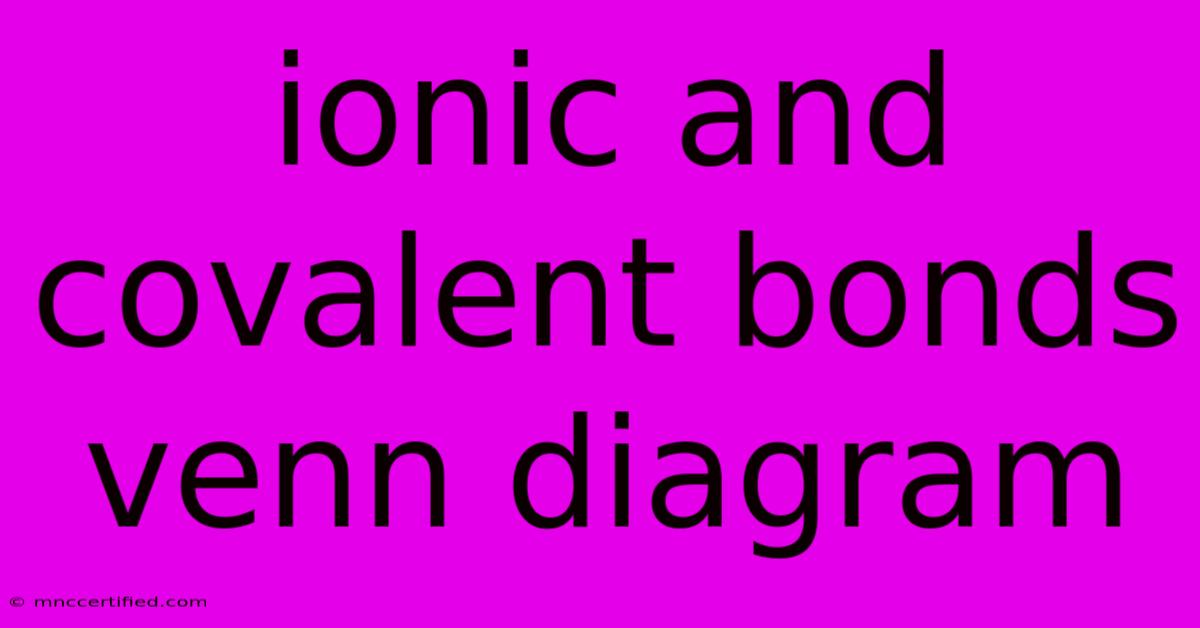Ionic And Covalent Bonds Venn Diagram

Table of Contents
Unveiling the Similarities and Differences: An Ionic and Covalent Bond Venn Diagram
Understanding the fundamental concepts of chemical bonding is crucial for comprehending the vast world of chemistry. Two prominent types of bonds, ionic and covalent, form the bedrock of countless compounds and reactions. While they share some similarities, their differences are equally important to grasp. This article will explore these nuances by using a Venn diagram to visually represent the shared characteristics and unique features of ionic and covalent bonds.
Venn Diagram: A Visual Representation of Bonding Types
!
Shared Characteristics (Overlapping Area):
- Formation of Stable Compounds: Both ionic and covalent bonds result in the formation of stable compounds by achieving a more stable electron configuration for the atoms involved.
- Electrostatic Attraction: Both types of bonds rely on electrostatic attraction, albeit with different mechanisms. In ionic bonds, it's the attraction between oppositely charged ions. In covalent bonds, it's the attraction between the shared electrons and the positively charged nuclei of the atoms.
Unique Characteristics (Non-Overlapping Areas):
Ionic Bonds:
- Electrotransfer: Electrons are completely transferred from one atom to another.
- Metal-Nonmetal: Typically formed between a metal and a nonmetal.
- High Melting and Boiling Points: Due to strong electrostatic interactions between ions.
- Good Conductors in Molten or Aqueous Solutions: Due to the presence of free-moving ions.
- Crystalline Structure: Ions arrange themselves in a regular, repeating pattern.
Covalent Bonds:
- Electron Sharing: Electrons are shared between two or more atoms.
- Nonmetal-Nonmetal: Typically formed between nonmetals.
- Lower Melting and Boiling Points: Generally lower than ionic compounds due to weaker intermolecular forces.
- Poor Conductors in Molten or Aqueous Solutions: Lack of free-moving charged particles.
- Molecular Structure: Atoms form distinct molecules with specific geometries.
Beyond the Diagram: Understanding the Nuances
While the Venn diagram provides a useful visual aid, it's crucial to remember that the reality of chemical bonding can be more complex. Here are some important points to consider:
- Polar Covalent Bonds: In some cases, covalent bonds involve unequal sharing of electrons, resulting in a partial positive and partial negative charge on the atoms. This phenomenon, known as polarity, introduces an ionic character to the bond.
- Metallic Bonding: A third type of bonding, metallic bonding, involves the delocalization of electrons within a lattice of metal atoms. This type of bonding exhibits characteristics not captured by the Venn diagram.
- Bond Strength and Properties: The strength of both ionic and covalent bonds can vary depending on the specific atoms involved. These differences influence the physical and chemical properties of the resulting compounds.
Conclusion: Embracing the Complexity
Understanding the similarities and differences between ionic and covalent bonds is essential for a comprehensive grasp of chemistry. While the Venn diagram provides a simple visual representation, the actual nature of chemical bonding is often more nuanced and complex. By delving deeper into the specifics of each bond type and considering the broader spectrum of chemical interactions, we can appreciate the intricate beauty and diversity of the molecular world.

Thank you for visiting our website wich cover about Ionic And Covalent Bonds Venn Diagram. We hope the information provided has been useful to you. Feel free to contact us if you have any questions or need further assistance. See you next time and dont miss to bookmark.
Featured Posts
-
City Fall To Brighton In Late Show Drama
Nov 10, 2024
-
Real Madrid 4 0 Osasuna Vinicius Jrs Hat Trick
Nov 10, 2024
-
Liverpool Vs Aston Villa Time Tv Stream 11 2 24
Nov 10, 2024
-
Live Stream Brighton Vs Man City Premier League
Nov 10, 2024
-
Mark Pope Amari Williams Played Fantastic
Nov 10, 2024